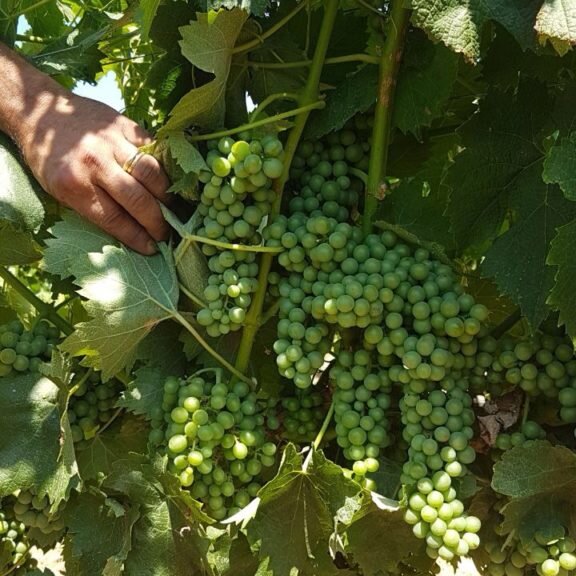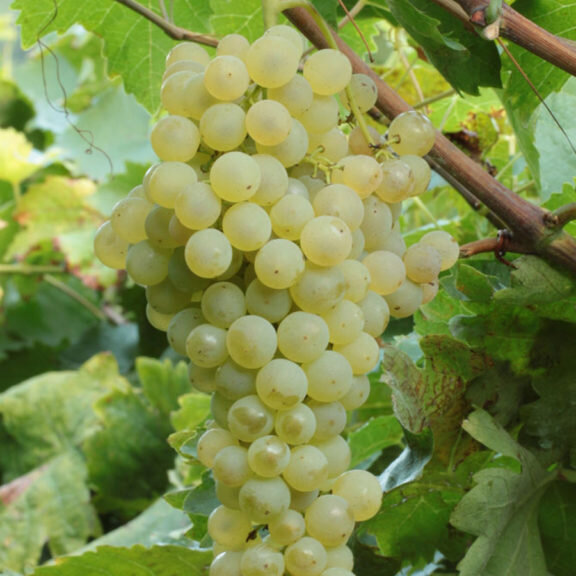White grapes
Grillo
Grillo, also known as Riddu, has a fairly recent history and can be considered the most modern among the white grape varieties cultivated in Sicily. This grape is a cross between Catarratto Bianco and Zibibbo (Moscato di Alessandria), developed by Baron Antonio Mendola of Favara (AG) (1827-1908).
A passionate agronomist and breeder, he experimented with new hybrids, and boasted a collection of over 4000 vine varieties. Initially called Moscato Cerletti, Grillo was truly born in 1874, when Baron Mendola wrote the following in his diary: “Seed of White Catarratto (FU), artificially fertilised with the zibibbo in the flowering of 1869 in my vineyard, Piana dei Periat Favara; harvested on 27th August of the same year; sewn in pots on March 3rd, 1870, and sprouting to life around May 20th. In 1871… nurtured a tiny shoot (Marza) and grafted it, in February 1872, over a sturdy stump… in order to hasten the bearing of fruit, and so I had the pleasure of enjoying the first bunches in autumn 1874”.
Today, this grape variety is included in the DOC grape variety group, of the Western centre of Sicily, but it is spreading throughout the region. Grillo is a source of wines of great depth and weight; organoleptic, savoury and fragrant, with hints ranging from jasmine to white melon, pear to pineapple, citrus, nettle and green pepper. Notably for a white wine, it is excellent after ageing.
Cataratto
Historically and quintessentially Sicilian, Catarratto was the progenitor of Garganega – a grape that, due to its high yield, rose to great acclaim throughout Veneto (Northern Italy) in the middle of the twentieth century.
In previous centuries it was used mainly in conjunction with Grillo and Inzolia for the production of Marsala. The subsequent decline of this famous fortified wine has led to a gradual decrease in the cultivation of Catarratto, which has lost some of its importance, to the gain of better known and more profitable international grape varieties.
In recent years, however, thanks to the valorisation of autochthonous grapes, vinified in sterile conditions, the singular qualities of Catarratto grapes have been rediscovered. Today, their presence constitutes yet another of the many precious attributes of the island.
Vigorous and productive, and traditionally cultivated from sapling, they ripen easily and fully. Catarratto give interesting wines, blessed with lively acidity, a contained alcoholic note and a clear mineral vein.
The straw-yellow wine’s bouquet breathes hawthorn, jasmine, aromatic herbs, citrus and white fruit.
Grecanico
Grecanico is a native Sicilian white grape variety, introduced to Southern Italy in the VII Century BC, by Greek colonisers.
Information on it dates back to the late Renaissance, when, in 1696, Gloomy referenced a vine which he called, simply, “Greek”. Later, in 1835, it was Abbot Jeremiah who mentioned it in his treatise Stafulegrafia, indicating its location throughout Trapani.
Today, the grape variety is also cultivated sporadically in Catania, and in the province of Caltanissetta. Grecanico is often used with other white grape varieties, infusing wines with discrete, floral, fruity bouquets, with hints of white melon, pineapple, plum and peach, and sometimes – after ageing – chocolate and meringue.
Zibibbo
Originating in Egypt, Zibibbo is cultivated in Pantelleria, and is thought to have been introduced to Sicily by the Phoenicians. The term “Zibibbo” has an interesting origin, deriving from the Arabic word “zabib”, meaning “raisins”.
In fact, the grapes produced by this vine are perfect for the drying process, after being harvested. On 26th November, 2014, Zibibbo was declared a UNESCO World Heritage Site for its agricultural practice of vine cultivation from saplings, a time-honoured, Pantellerian tradition. In Sicily – and with particular success in the areas between Erice and Mazara del Vallo – Zibibbo is now cultivated with a modern crop of spurred cordon.
Zibibbo matures quite slowly, yet presents voluminous bunches which, due to their particular sweetness, are also excellent as table grapes. They deliver a straw-yellow wine of great body, with golden reflections teasing out an elegant, fruity bouquet, sweetened with notes of apricot and almond.








